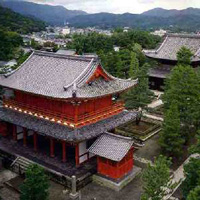【History】

On the western outskirts of Kyoto, not far from the mountains ringing the ancient capital, lies a gently rising plain blessed with fresh air and clear water. From ancient times the court nobility kept villas there surrounded by large landscape gardens, bright with flowering plants throughout the four seasons. In time the area came to be known as Hanazono 花園, meaning “flower garden.”
The ninety-fifth emperor of Japan loved this area and built his imperial villa there. Following his abdication in 1318 he took the name Hanazono and dedicated himself to the practice of Zen meditation under Zen master Shūhō Myōchō 宗峰妙超 and Shūhō’s disciple Kanzan Egen 関山慧玄. In 1337 the emperor converted his villa into a Zen temple.
This is the origin of Myōshin-ji (Temple of the Enlightened Mind), which over the centuries has grown to become the headquarters of the Myōshin-ji branch of the Rinzai Zen school. As with all Zen temples, Myōshin-ji has a “mountain name” (sangō), harking back to the time in China when most Zen temples were located in the mountains; Myōshin-ji’s mountain name is Shōbōzan 正法山 (Mountain of the True Dharma). Zen Master Kanzan Egen served as Myōshin-ji’s founding priest and the cloistered emperor Hanazono as its founding patron.
Myōshin-ji presently has forty-six subtemples (tatchū 塔頭) in its main temple complex and more than three thousand four hundred affiliated temples throughout Japan and the rest of the world. Approximately seven thousand monks are associated with the Myōshin-ji branch of Rinzai Zen. Also affiliated with the temple are such educational facilities as Hanazono University, Hanazono High School, Hanazono Middle School, and Rakusai-Hanazono Kindergarten.
| Period | A.D. | History | |
| 南 北 朝 |
Southern and Northern Dynasties (Nanboku−cho) | 1337 | The cloistered emperor Hanazono receives a Certificate of Dharma Transmission (inka 印可), from Zen master Shūhō Myōchō, the founder of Daitoku-ji Temple. Shūhō Myōchō, ill in bed, recommends that Hanazono continue his Zen practice under Myōchō’s disciple Kanzan Egen. Hanazono has his imperial villa on the western outskirts of Kyoto converted into a temple, to which Shūhō Myōchō gives the name Shobo-zan Myōshin-ji 正法山 妙心寺. Shūhō Myōchō passes away on December 22, 1337. Kanzan Egen becomes the founding abbot of Myōshin-ji. |
| 北 朝 |
Northern Dynasty (Hoku−cho) | 1338 | Following Shūhō’s death, Emperor Hanazono establishes the temple Gyokuhō-in 玉鳳院 on Myōshin-ji’s precincts and practices Zen under Kanzan Egen. |
| 1347 | Hanazono writes the “Ōnen no Goshinkan” 往年の御宸翰 to Kanzan. | ||
| 1348 | Hanazono passes away at the age of 51. | ||
| 1360 | Kanzan Egen passes away at the age of 83 and is honored with the imperial titles Hon-nu Enjō Kokushi 本有円成国師 and Musō Daishi 無相大師. | ||
| 1361 | Kanzan’s disciple Juō Sōhitsu 授翁宗弼 (1296–1380) is appointed second abbot of Myōshin-ji. | ||
| 1380 | Juō Sōhitsu passes away at the age of 84 and is accorded the posthumous titles Enkan Kokushi 円鑑国師 and Mimyo Daishi 微妙大師. | ||
| 室 町 |
Muromachi | 1399 | Shogun Ashikaga Yoshimitsu 足利義満(1358-1408) seizes Myōshin-ji’s property during the Ōei War and confines Setsudō Sōboku 拙堂宗朴(n.d.), the sixth chief abbot of Myōshin-ji, to house arrest in the temple Seiren-in 青蓮院. Myōshin-ji’s name is changed to Ryōun-ji 龍雲寺, and the temple is placed under the control of the Nanzen-ji School. |
| 1432 | Myōshin-ji’s property is restored, and the temple is rebuilt by Zen master Nippō Sōshun 日峰宗舜(1368-1448). | ||
| 1467 | Myōshin-ji and nearby Ryōan-ji are torched during the Onin War. | ||
| 1477 | Sekkō Sōshin 雪江宗深(1408-1486), the ninth abbot, rebuilds Myōshin-ji. | ||
| 1509 | The temple precincts are enlarged when the nun Riteini 利貞尼 purchases property from the nearby imperial temple Ninna-ji 仁和寺 and donates it to Myōshin-ji. | ||
| 江 戸 |
Edo | 1615 | The Edo shogunate enacts the Ji’in Hatto 寺院法度, a system of temple regulations in which Myōshin-ji and Daitoku-ji are placed under the control of the Edo government. |
| 1629 | Monks at Myōshin-ji and Daitoku-ji launch protests against the Ji’in Hatto. Four monks, including the Zen masters Tanden Shi’in 単伝士印(n.d.) and Takuan Sōhō 沢庵宗彭(1573-1645), are punished. This protest is known as the Purple Robe Incident (Shie jiken 紫衣事件). | ||
| 明 治 |
Meiji | 1868 | The Shinbutsu Bunri Rei 神仏分離令, an ordinance ordering the separation of Buddhism and Shinto, is passed soon after the fall of the feudal system and the establishment of the new Meiji government. This is followed by the Haibutsu Kishaku 廃仏棄釈 movement, a major suppression of Buddhism during which thousands of temples, Buddha images, and sutras are destroyed throughout the country. Although Myōshin-ji was among the temples affected by this movement, the Meiji era was also the period during which Myōshin-ji instituted its present administrative system, founded its Zen training monastery, and established the Hannya Rin 般若林 school, the forerunner of today’s Hanazono High School and Hanazono University. |

